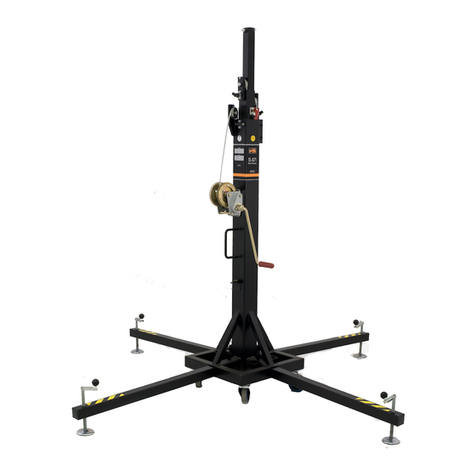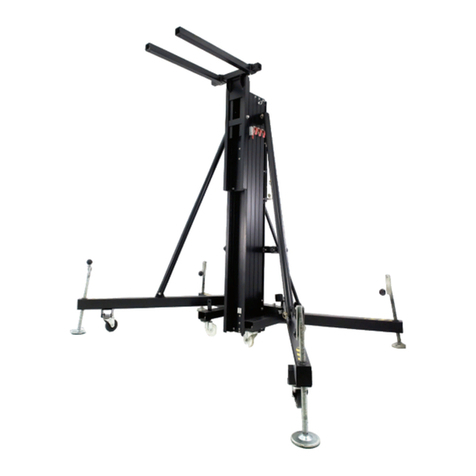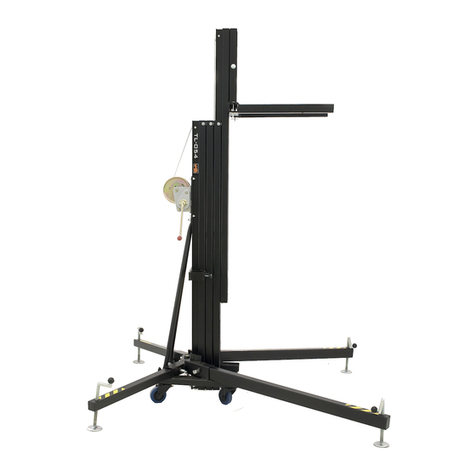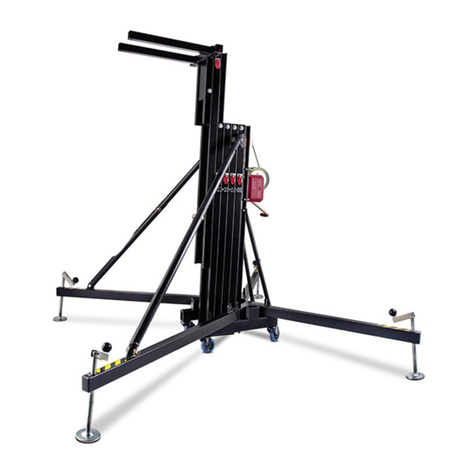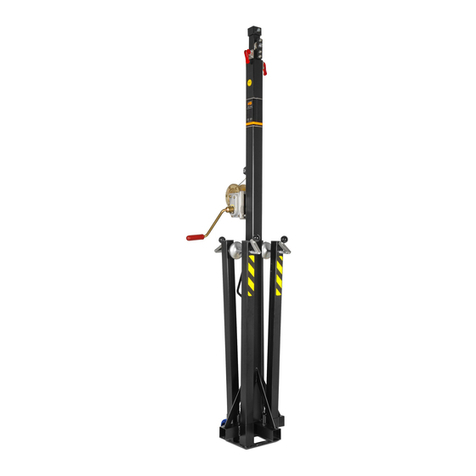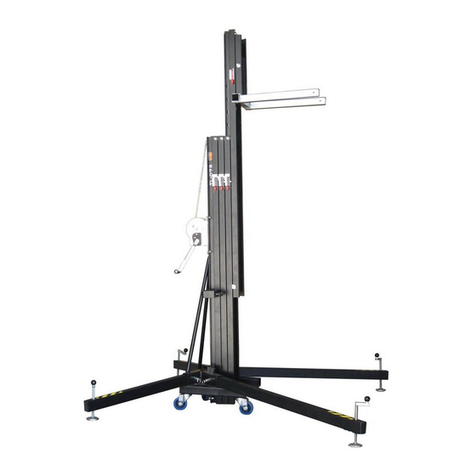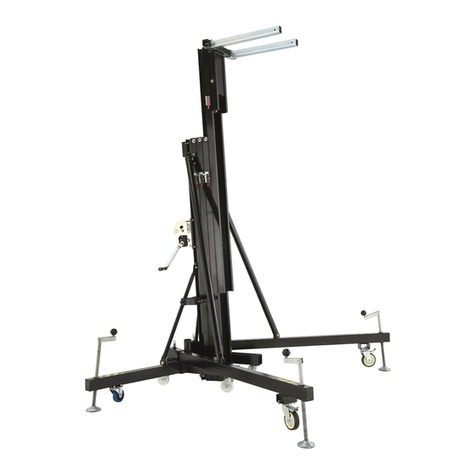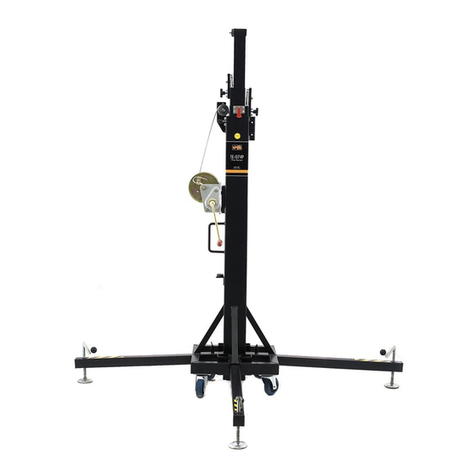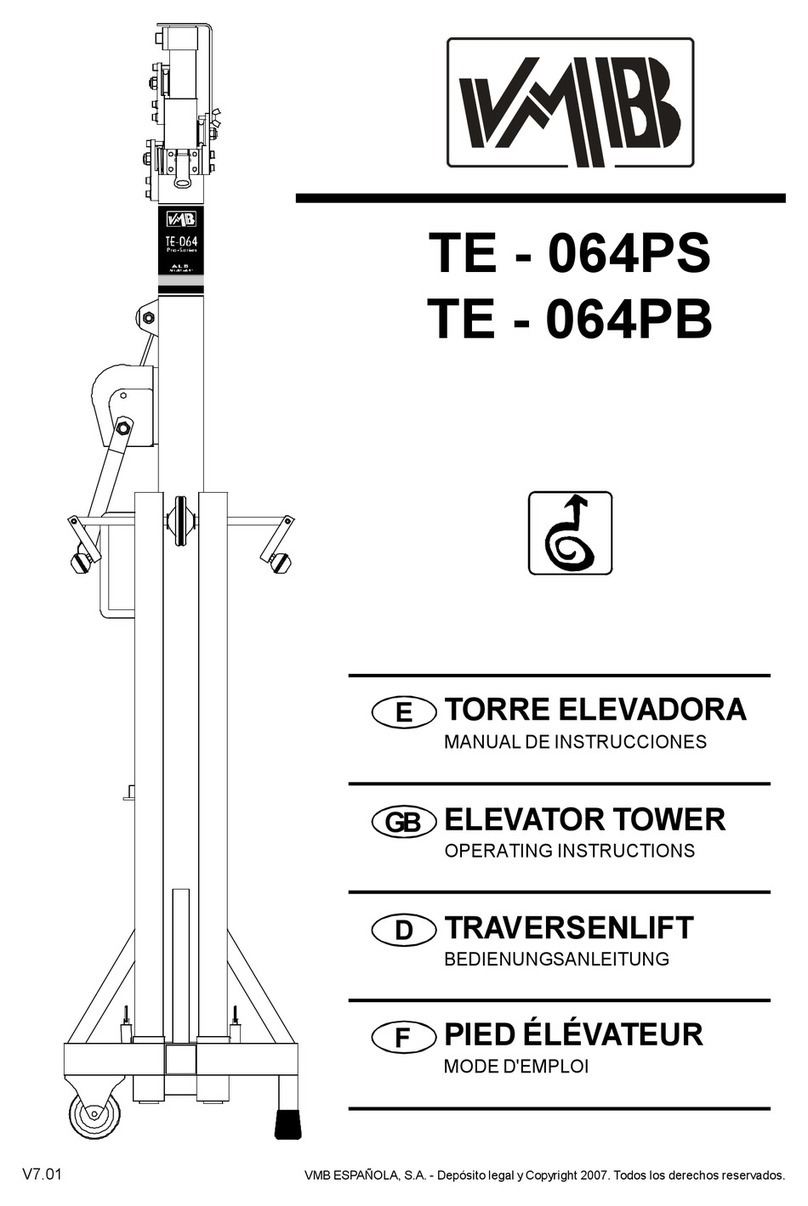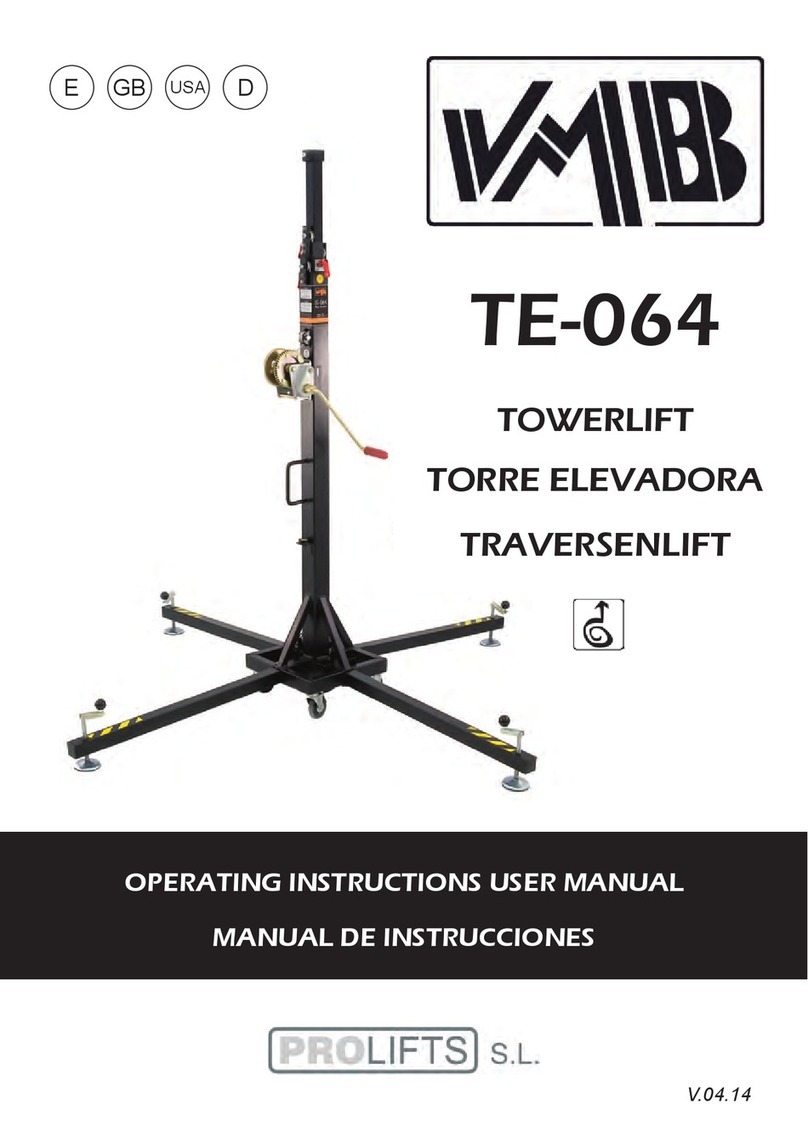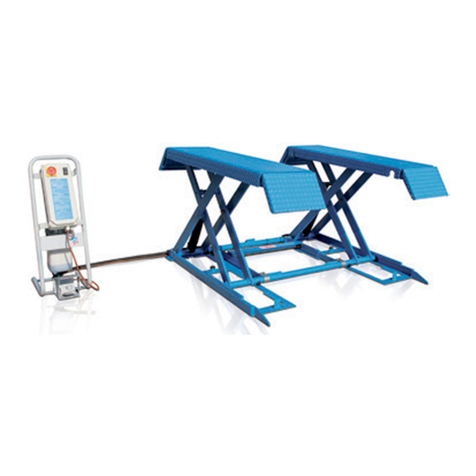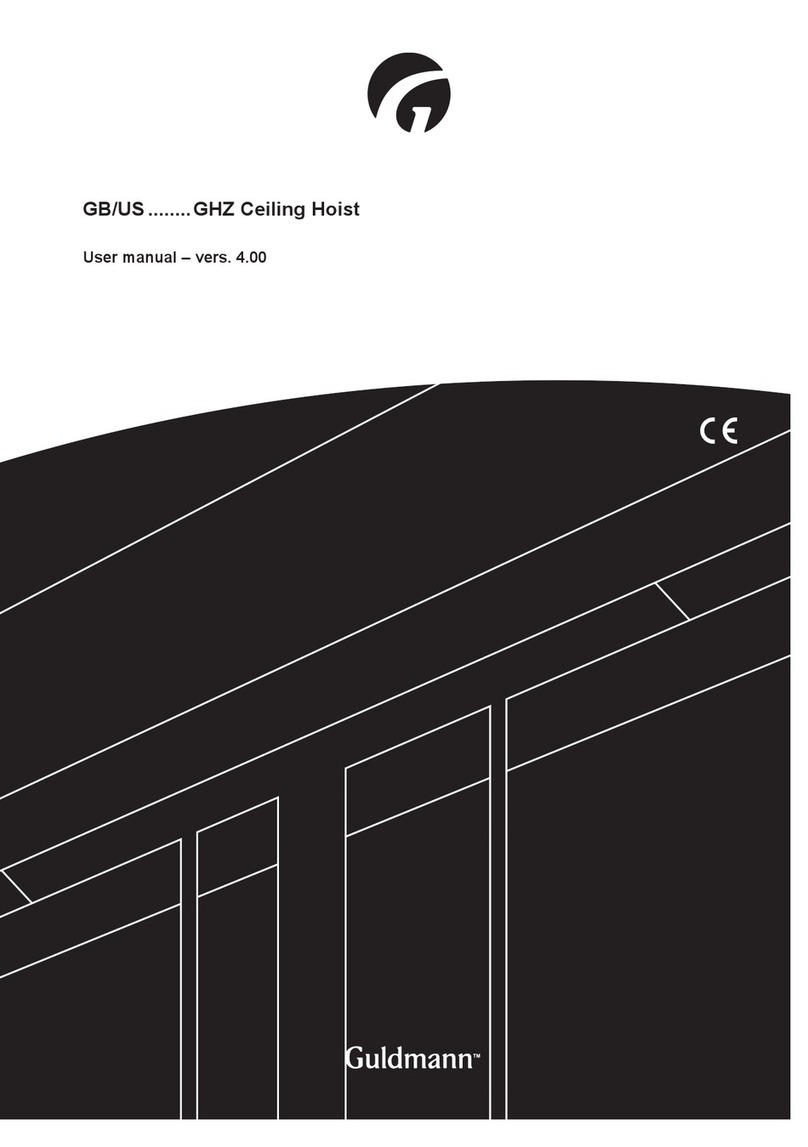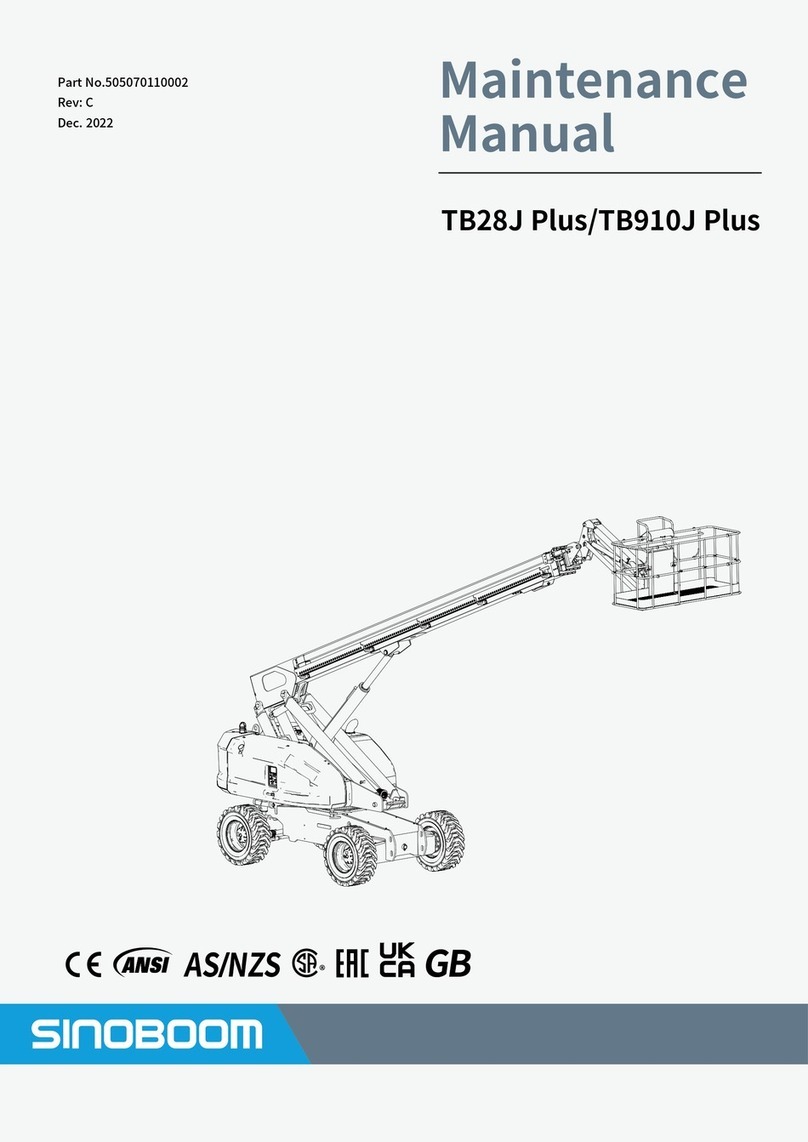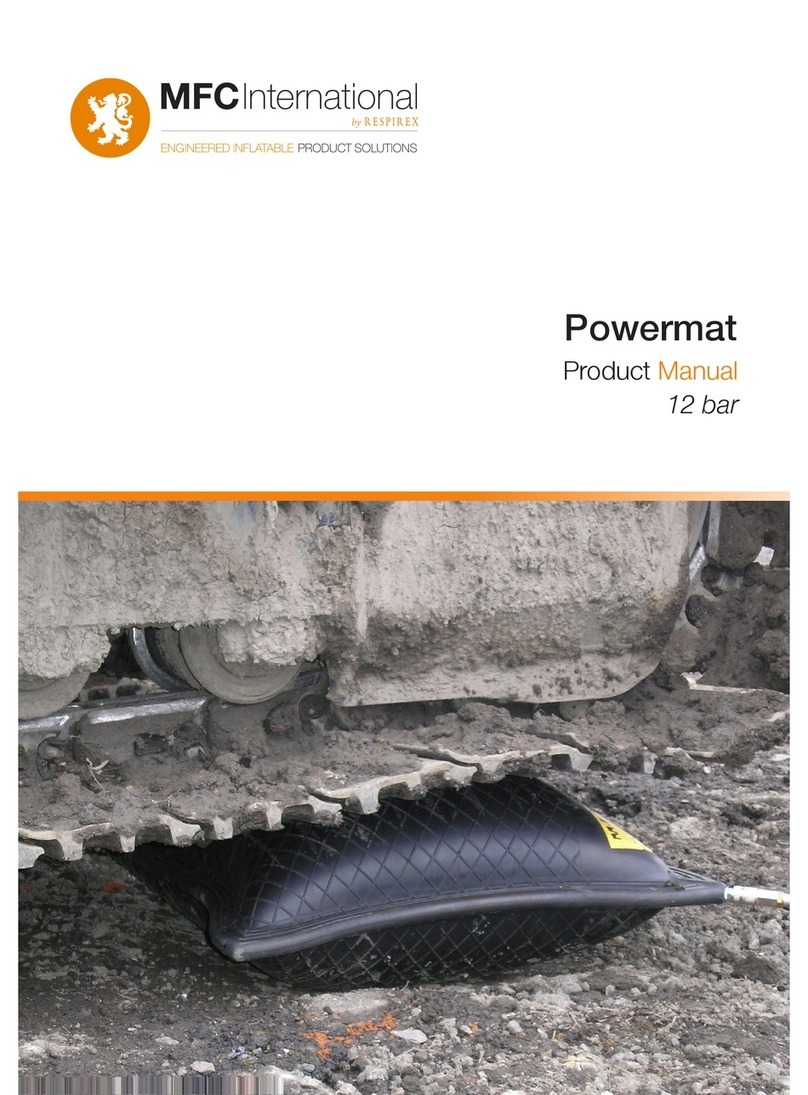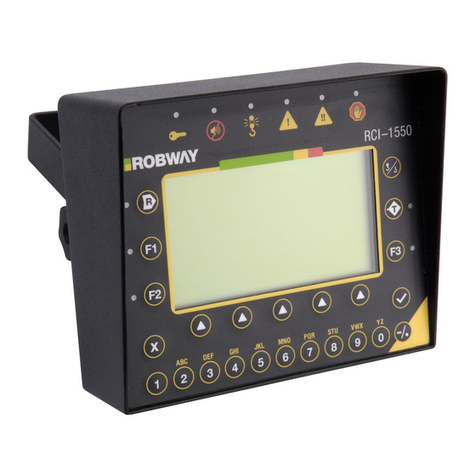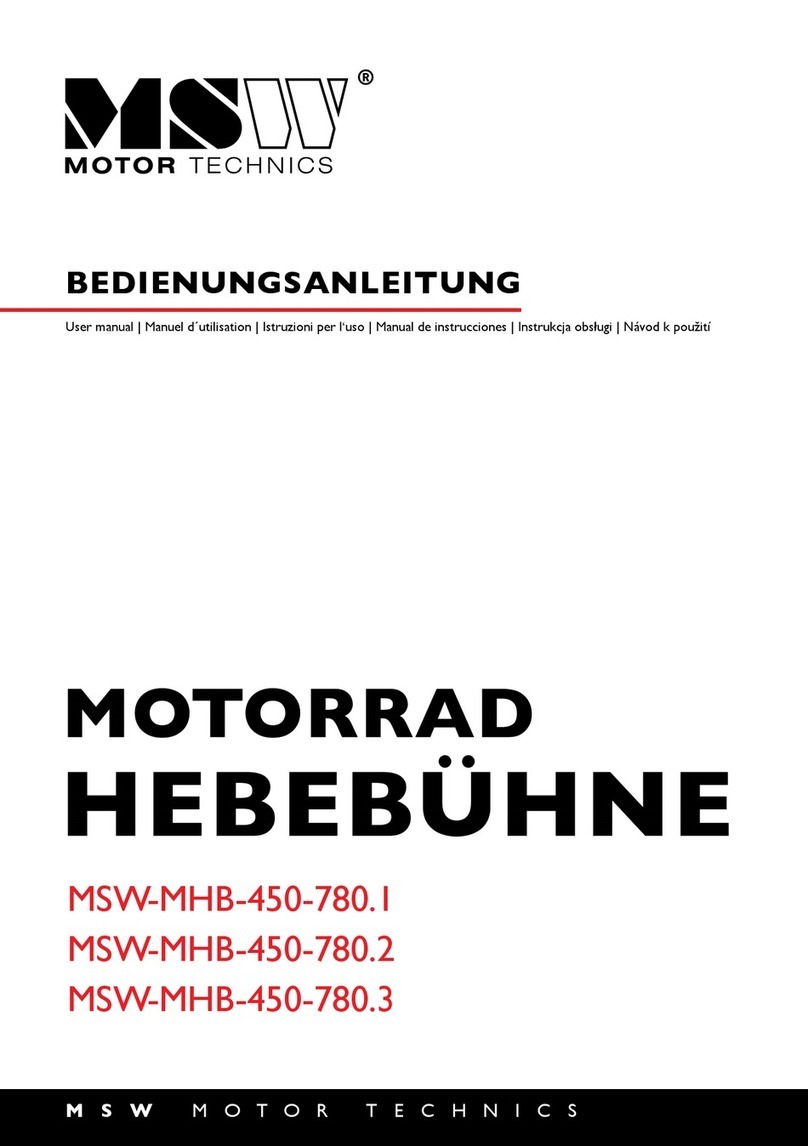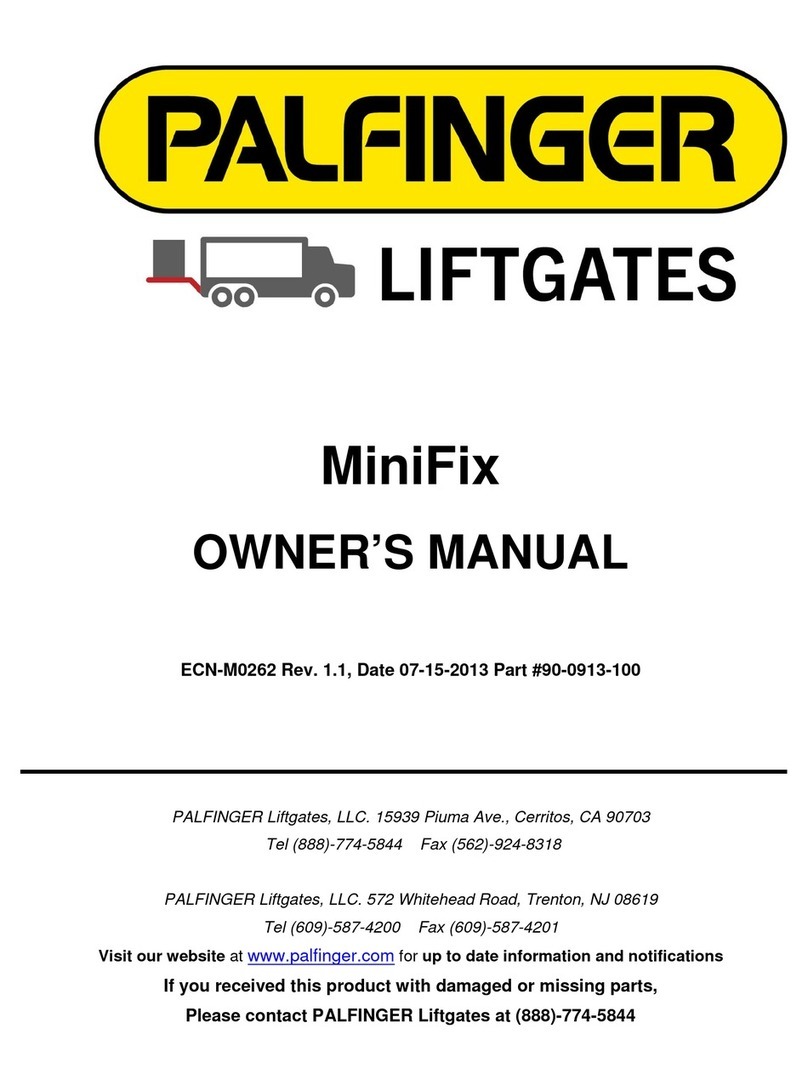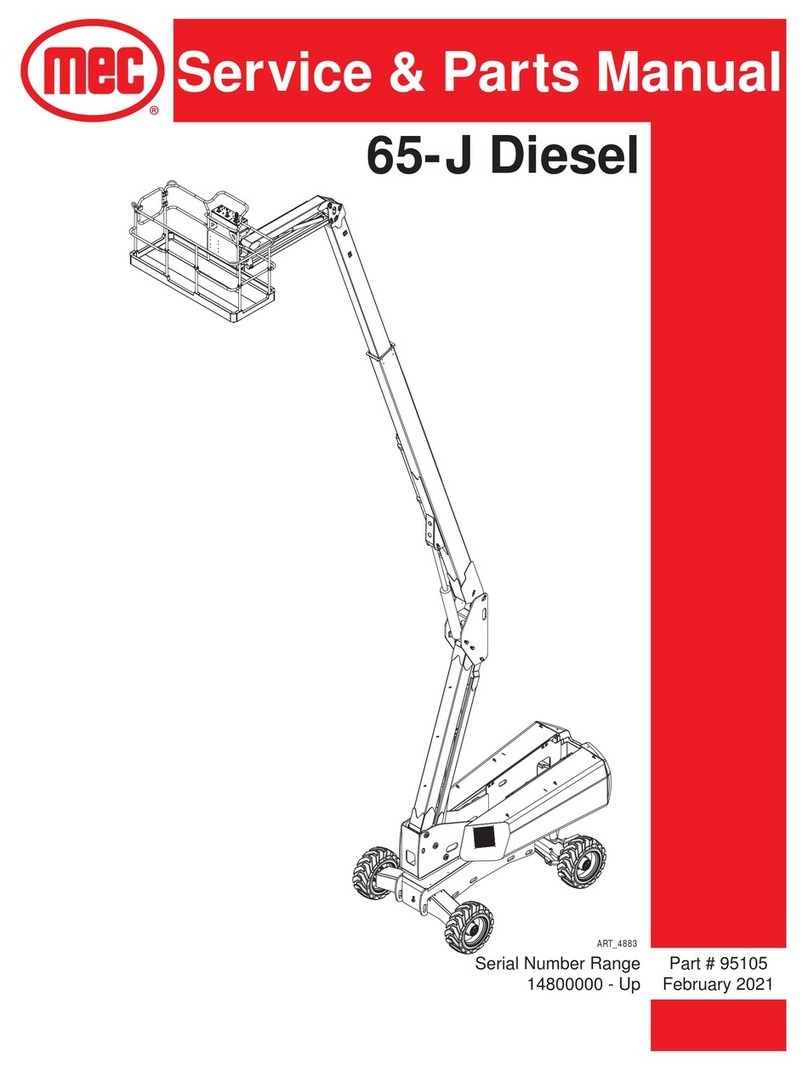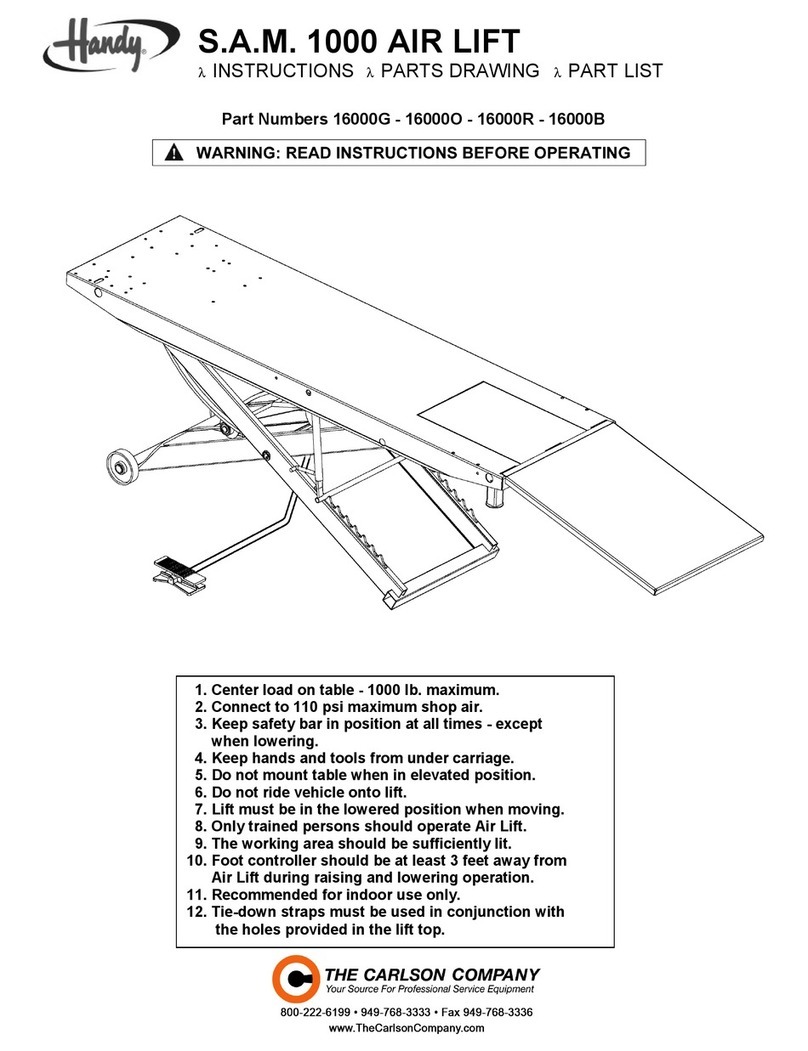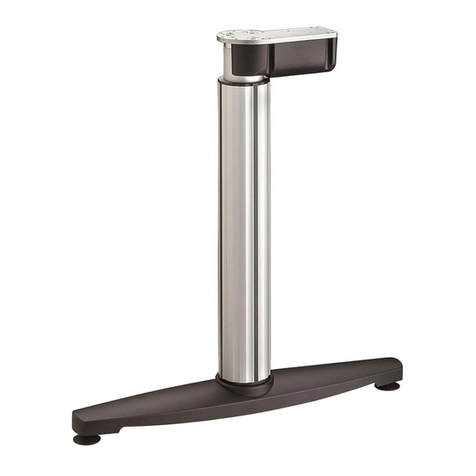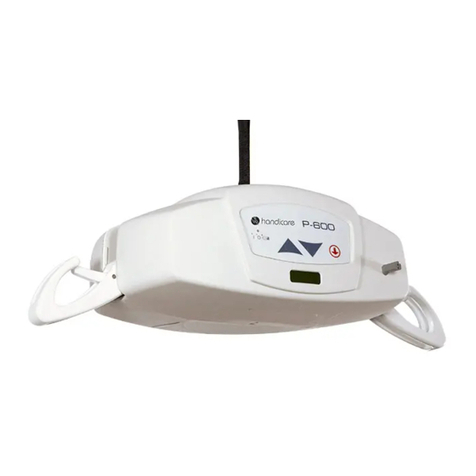VMB TL-A300 Instruction Manual

V.07.14
OPERATING INSTRUCTIONS USER MANUAL
MANUAL DE INSTRUCCIONES
TOWERLIFT
TORRE ELEVADORA
TL-A300
LINE ARRAY
GBE USA

LIFTING TOWER TL-A300
TORRE ELEVADORA TL-A300
PRO LIFTS S.L.
C/ Ciudad de Barcelona Nº19
Pol.Ind. Fuente del Jarro
46988 Paterna (Valencia)
Tlf Export: +34 96 171 81 86
Tlf Nacional: 96 171 81 83
Manufacturer - Fabricante
Este manual de usuario y catálogo anexo de piezas de repuesto es propiedad de PRO LIFTS S.L.
Queda prohibida su reproducción total o parcial por cualquier medio que la tecnología actual permita.
Deposito legal y copyright 2014. Todos los derechos reservados.
MADE IN SPAIN (EU)
BGV-C1
BGG-912
EC Conformity Declaration pursuant to the EC Machinery Directives 89/392/CE and
98/37/CE: Manual lifters
Find a copy of the certifications at the end of this booklet.
Puede ver una copia de las certificaciones al final del manual.
Features of the TL-A300 towerlift / Características TL-A300..............3 - 4
English Quick operation guide....................................................................5 - 11
Manual de usuario Español.......................................................................... 12 - 19
Sketches / Planos piezas................................................................................ 20 - 27
Spare part list / Lista de repuestos..............................................................28 - 30
Certifications / Certificaciones......................................................................31
CONTENTS / ÍNDICE

Depósito legal y copyright 2014. Todos los derechos reservados. 3PRO LIFTS S.L.
V
S
T
TL-A300
F
A: Reinforcement struts for line array / Refuerzo especial para Line Array
E: Anchor points for struts / Anclaje del tirante refuerzo frontal para Line Array
F: Load forks / Brazos de carga
N: Force on hand crank / Fuerza sobre manivela
S: Transport compartment for legs / Alojamiento de transporte para patas
T: Transport wheels / Ruedas de transporte
V: Working compartment for legs / Alojamiento de trabajo para patas
W: Winch / Cabrestante
V
A
E
T
W
W
W
N1
N2

Depósito legal y copyright 2014. Todos los derechos reservados. 4PRO LIFTS S.L.
TL-A300
ALS-C: Auto Lock System carriage /
Gatillo automático carro
ALS-1: Auto Lock System 1st profile /
Gatillo automático tramo 1
ALS-2: Auto Lock System 2nd profile /
Gatillo automático tramo 2
ALS-3: Auto Lock System 3rd profile /
Gatillo automático tramo 3
ALS-4: Auto Lock System 4th profile /
Gatillo automático tramo 4
E: Anchor points for struts /
Anclaje del tirante de refuerzo frontal
H: Handle / Manivela
L: Spirit level
P: Leg / Pata
Q: Stabilizer / Estabilizador
SRS: Sequence Retainer System
R: Catch pawl / Gatillo bloqueo patas
ALS-C
ALS-3
ALS-4
ALS-2
ALS-1
SRS
E
H
Q
PL
R

Depósito legal y copyright 2014. Todos los derechos reservados. 5PRO LIFTS S.L.
Quick operation guide ENGLISH
CONTENTS
1. Introduction.
2. Technical information.
3. Safety precautions.
4. Operation.
5. Maintenance.
6. Guarantee.
1. INTRODUCTION
Dear customer, in order to ensure a safe
and reliable operation of the TL-A300
towerlift please follow the instructions in
this booklet carefully. Before operating the
lift, read the instructions completely and
please note the technical information con-
tained within this manual.
All VMB products undergo very rigorous
testing, under strict conditions and they
are monitored continuously during the ma-
nufacturing process.
In order to guarantee the lifts function and
safety, only original parts from the manu-
facturer must be used. If any parts other
than those of the manufacturer are used,
or the product is modified in any way, the
user forfeits all warranty rights to claim.
VMB reserves the right to modify the pro-
duct specifications without prior notice.
The model type, production year and se-
rial number must be quoted in any queries
or orders for spare parts.
2. TECHNICAL INFORMATION
2.1 - TL-A300 Towerlift.
2.2 - Designed to lift audio systems, such
as PA systems or Line Array, up to diffe-
rent heights.
2.3 - Maximum load : 300 kg (662 lb).
2.4 - Minimum load: 25 Kg (55 lb).
2.5 - Security :
ALS (Automatic Lock System).
2.6 - Maximum height : 5.80 m (19’).
2.7 - Folded height : 1.58 m (5.2’).
2.8 - Work surface :
1.9 x 2.1 m (6.2’ x 6.9’).
2.9 - Unit weight : 165 Kg (364 lb).
2.10. - Load support:
Long forks (74.5 cm).
2.11 - Construction material : 6082-T6
alluminium for the main body, comprised
of 5 profiles and a lifting carriage. Base
and legs are made of steel profile accor-
ding to DIN 2394. Catches and pulleys of
ST-37 steel.
2.12 - Winch: 1200 Kg. maximum load
with automatic brake. Certification CE and
GS TÜV.
2.13 - Cable : Steel DIN 3060. Quality 180
Kg/mm2twist resistant.
Cable diameter: 6 mm.

Depósito legal y copyright 2014. Todos los derechos reservados. 6PRO LIFTS S.L.
Quick operation guide ENGLISH
3. SAFETY PRECAUTIONS.
2.14 - Adjustable stabilizing feet with rub-
ber non-slip supports.
2.15 - Safety catches to anchor the legs.
2.16 - Antirust protection, primed paint
with cured polyester dust cover. The tower
can be supplied with natural aluminium
finish or black (version B).
2.17 - Spirit level to adjust the tower ver-
tically.
2.18 - Swivel wheels to transport the lift
when folded.
3.1 - The TL-A300 is a machine designed to elevate
loads upwards in a vertical direction, It should NEVER
be used as a platform to elevate people.
3.3 - The maximum load indicated on the characteristics
label and the instructions manual should not be excee-
ded.
3.4 - This lift should NEVER be used to elevate a load
that has not been properly checked. It is necessary to
verify that the load is correctly supported and centred
on the appropriate lift support so that the weight of the
load will only elevate in a vertical direction.
3.2 - Only place the lift on hard, flat surfaces always
checking that it is in a vertical position by using the bub-
ble level indicator (L) found on the base. Adjust the leg
stabilizers (Q) by turning the handles (H) to level if ne-
cessary. NEVER use wedges or other foreign objects to
balance the lift.

Depósito legal y copyright 2014. Todos los derechos reservados. 7PRO LIFTS S.L.
Quick operation guide ENGLISH
3.6 - NEVER use the lift on a vehicle or any other mobile
surface.
3.7 - If there is a possibility of strong winds or gusts,
place the lift on the ground firmly and secure it with the
use of straps. NEVER attach a strap to a vehicle or any
other object that can possibly be moved.
3.8 - NEVER move the lift whilst it is carrying a load. It
is not advisable to carry out any type of horizontal mo-
vement even small positional adjustments.
3.9 - NEVER allow any team member below the load or
anybody else in the lifts operating zone.
3.10 - Take care with all obstacles above the lift and
its extension zone such as cornices, balconies, and
luminous signboards. It is very important to avoid the
presence of all types of cables below the extended lift.
3.5 - Check that the legs (P) are placed and set-up co-
rrectly with their safety pins (R) inserted and locked.

Depósito legal y copyright 2014. Todos los derechos reservados. 8PRO LIFTS S.L.
Quick operation guide ENGLISH
3.11 - Do not use stepladders on the lift or use it as a
support for them.
3.12 - Before using the lift, check the condition of the
cable. The cable should not have broken threads or
show any signs of crushed/flattened areas. NEVER use
faulty cables, always change them if there is any doubt.
Only use VMB steel cables; reference: DIN 3060.
Quality: 180KG/mm and torsion resistant.
3.14 - Do not grease or lubricate the winch’s braking
mechanism. The brake disks have been greased with
a special heat and pressure resistant solution. Other
products should not be used to avoid negative effects
regarding the braking mechanism.
3.15 - The minimum load to avoid problems regarding
the braking mechanism is 25Kg. Without this load the
brake will not work.
3.16 - NEVER take apart the crank of the winch when
the lift is carrying a load or extended.
3.13 - All sections must be lowered first, and the legs
placed in its transport position, before transportation.

Depósito legal y copyright 2014. Todos los derechos reservados. 9PRO LIFTS S.L.
Quick operation guide ENGLISH
3.17 - Only original replacement parts should be used.
ORIGINAL
4. USER INSTRUCTIONS.
4.1 - Place the lift on a firm, flat surface
in the area it is to be used with the help of
the transport wheels (T).
4.2 - Remove the legs (P) from their trans-
port compartment (S) and fully insert them
into their working positions (V) checking
that they are fixed by the pins (R). Remo-
ve the reinforcement struts (A) as well and
place them in their anchor points (E), fix
them with their corresponding pins and
clips.
4.3 - Check that the lift is in vertical posi-
tion using the spirit level (L) at the base of
the tower, adjust the stabilizer (Q), turning
the handle (H) if necesary.
4.4 - Release the forks (F) and place them
in its working horizontal position ready to
take the load on them. Insert the pins to
block the forks.
4.5 - DO NOT OVERLOAD THE LIFT.
MAXIMUM LOAD IS 300 kg (662 lb)
The lift should NEVER be overloaded.
Safety at work is the most important is-
sue. Place the load onto the lift using an
adequate VMB support according to the
need, use so that the weight of the load
will only be elevated in a vertical direction.
The minimum load is 25 Kg.
4.6 - How to place the load: Always load
as close to the tower as possible.
The maximum load diminishes according
to the distance from the body of the tower
as illustrated in the diagram 4.6.1, which
shows the load on the gravity centre with
distances to the lifting carriage at a maxi-
mum lifting. Use a VMB adaptor if neces-
sary.
CAUTION
When two towers are used to elevate a
truss bridge, or many towers to elevate a
structure of any type, it is almost impos-
sible that two or more people co-ordinate
the winches elevating or lowering the
loads, at exactly the same pace. At a cer-
tain point each tower will be extended to
different height. For this reason it is ne-
cessary that the structure does not stretch
and allows for these differences.
With a rigid fixation and if the level diffe-
rence is significant, the force generated
from the handle of the winch will deform
the structure and apply a lateral force to
the lifts causing them to break and block.

Depósito legal y copyright 2014. Todos los derechos reservados. 10PRO LIFTS S.L.
Quick operation guide ENGLISH
B
C
D
E
A
4.7 - Elevation:
Turn the winch crank clockwise (N1) to lift
the carriage and profiles. The ALS sys-
tem enable the lift to rise and automati-
cally block the carriage and profiles whilst
rising ensuring that it will never fall. This
enables the cable to be without any force
and means it is only used for the elevation
and descent of the lift. The SRS (Sequen-
ce-Retainer-System) will also ensure that
the profiles rise in sequence, one after the
other.
4.8 - Hold:
The tower can be left in any intermediate
position if it is necessary. Just stop turning
the handle of the winch and gently turn it
in an anticlockwise direction (N2) to block
the last profile risen. The ALS lock will
take the pressure of the load and release
strain applied on the cable.
4.9 - Lowering:
To bring the lift down you need to first turn
the winch handle slightly clockwise (N1)
and at the same time pull the red ALS
lock (ALS-1) out. This releases the bloc-
king systems. Then turn the handle anti-
clockwise (N2), whilst maintaining the ALS
lock pulled out until the profile has been
completely lowered. All red ALS locks
(ALS-2, ALS-3 , ALS-4 & ALS-C) should
be pulled out one by one whilst the handle
is turned anti-clockwise (N2) and the profi-
les are brought down, one by one.
Security system ALS / ILS
The TL-A300 incorporates the patented
security system ALS (Automatic Lock
Security). This VMB red trigger system
automatically blocks the tower in the po-
sition it is left in. Each section of lift has
an ALS that blocks the section in the un-
likely event of the cable breaking. For a
more complete security the lifting carriage
incorporates the ILS system (Inertial Lock
Security)
Diagram 4.6.1
Distance from the
load’s center to the
axel of the tower
Maximum load
TL-A300
A50 cm
(1.64’)
300 kg
(662 lb)
B55 cm
(1.80’)
272 kg
(600 lb)
C60 cm
(1.97’)
250 kg
(551 lb)
D65 cm
(2.13’)
230 kg
(507 lb)
E70 cm
(2.30’)
182 kg
(400 lb)

Depósito legal y copyright 2014. Todos los derechos reservados. 11PRO LIFTS S.L.
Quick operation guide ENGLISH
spiral of the crank, and the sections.
5.3 - All lifts should undergo an annual
technical inspection carried out by an
authorized VMB dealer to check the cer-
tifications and general condition of all the
lift’s elements and security systems invol-
ved in the lift’s use.
5.4 - Only use original spare parts to gua-
rantee a continued security level. The
user loses all rights to warranty if any spa-
re parts other than originals are used or
carries out any modification or alteration
to the towerlift.
5.5 - To request a spare part please in-
dicate the corresponding code which can
be found in this manual together with the
lift’s serial number and year of manufac-
ture.
6. GUARANTEE.
The warranty period for this lift is 2 years
from the date of purchase.
PRO LIFTS S.L. promises, that from the
date of purchase and during the warranty
period to resolve any faults that may oc-
cur, produced through defect material or
fabrication. Damage caused by improper
use, product modification, third party ma-
nipulation or accidental fire are not cove-
red by this warranty.
If you release your finger from the ALS
lock it will automatically block. In this
case, repeat the first operation by turning
slightly clockwise (N1) and then anti-cloc-
kwise (N2) whilst always pulling the red
ALS lock out. It is necessary to completely
lower each profile before starting to lower
the next. DO NOT pull another red ALS
lock without having completely lowered
the previous profile.
4.10 - Transport:
For the transport of the tower is necessary
to fold the machine lowering every profile
completely. Once the towerlift is comple-
tely folded, place the legs and the struts
(A) in their transport compartment (S) lo-
cated at the legs, then the lift will be ready
to be transported.
5. MAINTENANCE.
5.1 - Regularly check the state of the ca-
ble. If the cable has broken threads, or if
it shows any signs of crushed/flattened
areas, it should be changed and replaced
immediately with a new one. Do not use
the lift if the cables are in bad condition.
Only use VMB steel cables reference: DIN
3060 torsion resistant.
5.2 - The lift is supplied from the factory
completely greased. However, it is recom-
mended to periodically grease according
to use, the gearing, the axis bearings, the

Depósito legal y copyright 2014. Todos los derechos reservados. 12PRO LIFTS S.L.
Manual de usuario ESPAÑOL
CONTENIDO
1. Introducción.
2. Información técnica.
3. Precauciones de seguridad.
4. Instrucciones de uso.
5. Mantenimiento.
6. Garantía.
1. INTRODUCCIÓN
Estimado cliente: Con el fin de garantizar
un funcionamiento seguro y fiable de la
torre elevadora TL-A300 por favor, siga
cuidadosamente las instrucciones de este
manual. Antes de manipular la torre ele-
vadora, lea las instrucciones completas
y tenga en cuenta la información técni-
ca contenida en este manual. Todos los
productos de VMB se someten a pruebas
muy rigurosas, en condiciones estrictas y
son monitorizados continuamente duran-
te el proceso de fabricación. Con el fin de
garantizar el correcto funcionamiento y
seguridad de los elevadores, sólo deben
ser utilizadas piezas originales del fabri-
cante. Si se utilizan piezas que no sean
las originales del fabricante, o el producto
se modifica de alguna manera, el usuario
pierde todos los derechos de garantía.
VMB se reserva el derecho de modificar
las especificaciones y las piezas del pro-
ducto sin previo aviso. El tipo de modelo,
año de producción y el número de serie
deben ser citadas en cualquier consulta o
pedido de piezas de recambio.
2. INFORMACIÓN TÉCNICA
2.1 - Torre elevadora TL-A300.
2.2 - Diseñada para levantar sistemas de
audio, como sistemas de Line Array o PA,
en sentido vertical a diferentes alturas.
2.3 - Carga máxima: 300 kg (662 lb).
2.4 - Carga mínima: 25 Kg (55 lb).
2.5 - Seguridad: ALS (Sistema de gatillo
automático de seguridad).
2.6 - Altura máxima: 5.8 m (19’).
2.7 - Altura plegada: 1,58 m (5.2’).
2.8 - Área de la base:
1.9 x 2.1 m (6.2’ x 6.9’).
2.9 - Peso de la torre: 165 kg (364 lb).
2.10 - Soporte de carga:
Brazos de carga largos (74.5cm).
2.11 - Material de construcción: Cuerpo
principal de cinco tramos más carro ele-
vador en perfil de aluminio extrusionado
6082-T6. Base, patas y soportes varios,
en perfileria de acero según DIN 2394.
Gatillos de seguridad y poleas acanala-
das en acero ST-37.
2.12 - Cabrestante: 1200 kg de carga
máxima con freno automático de retención
de la carga. Certificación CE y GS TÜV.
2.13 - Cable: Acero DIN 3060. Calidad de
resistencia a la torsión 180 kg/mm2.
Diámetro del cable: 6 mm.

Depósito legal y copyright 2014. Todos los derechos reservados. 13PRO LIFTS S.L.
Manual de usuario ESPAÑOL
3. PRECAUCIONES DE SEGURIDAD
2.14 - Patas estabilizadoras ajustables
con soportes de goma antideslizante.
2.15 - Gatillos de seguirdad para anclar
las patas.
2.16 - Protección anti-óxido, imprimación
con pintura de polvo poliester al horno. La
torre puede ser suministrada con acaba-
do natural de aluminio o negro (versión
B).
2.17 - Nivel de burbuja para ajustar la ver-
ticalidad de la torre.
2.18 - Ruedas direccionales para el trans-
porte de la torre cuando este plegada.
3.1 - La torre elevadora TL-A300 es una máquna diseñada
para la elevación de cargas en dirección vertical. NUNCA
se debe utilizar como plataforma eleavadora de personas.
3.3 - La carga máxima indicada en las características téc-
nicas mostradas en la etiqueta de la torre o en este manual
NO deben ser excedidas.
3.2 - Colocar el elevador sólo en superficies firmes y planas,
verificando que está en posición vertical, utilizando el indi-
cador de nivel de burbuja (L) que se encuentra en la base.
Ajuste los estabilizadores (Q) girando las manivelas (H)
hasta nivelar, si es necesario. Nunca utilice cuñas u otros
objetos extraños para equilibrar el elevador.
3.4 - Este elevador NUNCA debe utilizarse para elevar una
carga que no ha sido correctamente revisada. Es necesario
verificar que la carga está correctamente apoyada y centra-
da en el soporte de elevación apropiado para que el peso de
la carga sólo actúe en una dirección vertical.

Depósito legal y copyright 2014. Todos los derechos reservados. 14PRO LIFTS S.L.
Manual de usuario ESPAÑOL
3.6 - NUNCA use el elevador sobre un vehículo o cualquier
superficie móvil.
3.7 - Si existe la posibilidad de vientos fuertes o ráfagas,
coloque el elevador en el suelo con firmeza y fijelo median-
te tirantes tensores. Nunca fije un tirante a un vehículo o
cualquier otro objeto que se pueda mover.
3.8 - NUNCA mueva el elevador mientras esté cargado. No
es aconsejable llevar a cabo cualquier tipo de movimiento
horizontal, ni tan sólo pequeños ajustes de posición.
3.9 - NUNCA permita que ningún miembro del equipo o
cualquier otra persona se sitúe debajo de la carga en la
zona de operación de las torres elevadoras.
3.5 - Comprobar que las patas (P) estén situadas correcta-
mente, y fijadas con los gatillos de seguridad (R) los cuales
deben estar introducidos y bloqueados.
3.10 - Tenga cuidado con todos los obstáculos por encima
de la elevación y su zona de extensión, como cornisas,
balcones, letreros luminosos, etc. Es muy importante evi-
tar la presencia de todo tipo de cables por debajo de la
torre extendida.

Depósito legal y copyright 2014. Todos los derechos reservados. 15PRO LIFTS S.L.
Manual de usuario ESPAÑOL
3.12 - Antes de utilizar el elevador, compruebe el estado
del cable. El cable no debe contener hilos rotos o mostrar
signos de áreas aplastadas/aplanadas.
NUNCA use cables defectuosos, siempre debe cambiarlos
si hay alguna duda. Utilice solamente cable de acero VMB
referencia: DIN 3060. Calidad: 180kg/mm y resistente a la
torsión.
3.13 - Antes de transportar la torre, todos los tramos deben
ser bajados, y las patas deben extraerse y colocarse en su
posición de transporte.
3.14 - No engrasar ni lubricar el mecanismo de freno del
cabestrante. Los discos de freno vienen engrasados con
una solución especial resistente a la presión y al calor. No
deben utilizarse otros productos, para evitar los efectos
negativos sobre el mecanismo de frenado.
3.15 - La carga mínima para evitar problemas relaciona-
dos con el mecanismo de rotura es 25 kg. Sin esta carga
mínima el freno no funcionará.
3.11 - No usar escaleras encima del elevador ni utilizarlo
como un apoyo para éstas.
3.16 - NUNCA desmontar la manivela del cabrestante
cuando el elevador está soportando una carga o exten-
dido.

Depósito legal y copyright 2014. Todos los derechos reservados. 16PRO LIFTS S.L.
Manual de usuario ESPAÑOL
4. INSTRUCCIONES DE USO.
4.1 - Coloque el elevador sobre una su-
perficie firme y plana de la zona de traba-
jo sirviendose de las ruedas direccionales
de transporte (T).
4.2 - Extraiga las patas (P) de su aloja-
miento para transporte (S) e insertelas
totalmente en su posición de trabajo (V),
comprobando que los gatillos de seguri-
dad (R) se insertan y fijan la pata. Extrai-
ga también los tirantes de apoyo especial
(A) y coloquelos en su posición de sujec-
ción (E) asegurandolos con su pasador y
clip de seguridad.
4.3 - Compruebe que la torre esta en
posición vertical sirviendose del nivel de
burbuja (L) situado en el perfil base, si es
necesario ajuste la vertical de la torre con
los estabilizadores (Q) de las patas, giran-
do las manivelas (H).
4.4 - Libere los brazos de carga (F) y co-
loquelos en posición horizontal e inserte
los pasadores de seguridad con sus clips.
4.5 - LA CARGA MÁXIMA PARA
TL-A300 ES 300 kg (662 lb).
La torre elevadora NUNCA debe ser so-
brecargada. La Seguridad en el Trabajo
es el elemento más importante. Coloque
la carga en el elevador mediante un so-
porte adecuado según la necesidad de
modo que el peso de la carga sólo actúe
en dirección vertical. La carga mínima
son 25 kg.
4.6 - Como colocar la carga:
Cargue siempre tan cerca de la torre
como pueda. La capacidad de carga de
la torre decrece cuanto más lejos este la
carga separada de la torre, como se ilus-
tra en el esquema (4.6.1) de la siguiente
página. El cual muestra la carga en su
centro de gravedad con distancias al ca-
rro elevador que sostiene los brazos y a
máxima altura.
PRECAUCIÓN
Cuando se utilizan dos torres para elevar
un puente, descender truss o varias torres
para elevar una estructura de cualquier
tipo, es casi imposible que dos o más per-
sonas coordinen los cabrestantes exacta-
mente a la misma velocidad al elevar o
bajar las cargas. En un momento deter-
minado cada torre se elevará a una altura
3.17 - Sólo deben ser utilizadas piezas de repuesto
originales de VMB PRO LIFTS S.L.
ORIGINAL

Depósito legal y copyright 2014. Todos los derechos reservados. 17PRO LIFTS S.L.
Manual de usuario ESPAÑOL
B
C
D
E
A
Sistema de seguridad ALS / ILS
El TL-A300 incorpora el sistema de segu-
ridad patentado ALS (bloqueo automático
de seguridad). Este sistema VMB de gati-
llo rojo bloquea automáticamente la torre
en la posición que se deja. Cada tramo
de elevación tiene un ALS que bloquea
el tramo en el caso improbable de que el
cable se rompa. Para aún más seguridad
el carro también incorpora el sistema ILS
de bloqueo de inercia.
4.7 - Elevación:
Gire la manivela del cabestrante en sen-
tido horario (N1) para elevar el carro y los
tramos. El sistema de gatillos ALS le per-
mitirá elevar todos los tramos mientras
que estos se van bloqueando automáti-
camente, asegurando que la torre nunca
caerá. Esto hace que no actue ninguna
fuerza sobre el cable mientras la torre
esta parada, lo que significa que solo será
usado para elevar y descender la torre.
El sistema único SRS permite que los
perfiles se eleven de forma secuencial u
ordenada, uno detrás de otro.
4.8 - Bloqueo:
La torre puede dejarse en cualquier po-
sición intermedia si se requiere. Una vez
el sistema esta elevado hasta la altura
deseada tan solo deje de girar la mani-
vela y el freno automático del cabrestan-
diferente a la de las demás. Por ello, es
necesario que la estructura no se esti-
re y permita estas diferencias. Con una
fijación rígida y si la diferencia de nivel es
importante, la fuerza generada a partir de
la manivela del cabrestante deformará la
estructura y aplicará una fuerza lateral a
los elevadores provocando su bloqueo y
ruptura.
Esquema 4.6.1
Distancia del
centro de la carga
al eje de la torre
Carga Máxima
TL-A300
A50 cm
(1.64’)
300 kg
(662 lb)
B55 cm
(1.80’)
272 kg
(600 lb)
C60 cm
(1.97’)
250 kg
(551 lb)
D65 cm
(2.13’)
230 kg
(507 lb)
E70 cm
(2.30’)
182 kg
(400 lb)

Depósito legal y copyright 2014. Todos los derechos reservados. 18PRO LIFTS S.L.
Manual de usuario ESPAÑOL
4.7 - Transporte:
Para el transporte de la torre es necesa-
rio bajar completamente todos los tramos.
Una vez la torre haya sido plegada, co-
loque las patas y los tirantes de refuerzo
especial para Line Array en su alojamien-
to para transporte (S), y la torre ya estará
lista para su transporte.
5. MANTENIMIENTO
5.1 - Comprobar periódicamente el esta-
do del cable. Si en el cable existen hilos
rotos, o si muestra signos de zonas aplas-
tadas/aplanadas, debe ser sustituido in-
mediatamente por uno nuevo. No use el
elevador si los cables están en mal esta-
do. Utilice solamente cable de acero DIN
3060 resistente a la torsión.
5.2 - La torre elevadora es suministrada
de fábrica completamente engrasada.
Sin embargo, se recomienda un engrase
periódico, según el uso, de las ruedas de
fricción, los cojinetes de eje, la espiral de
la manivela, y los tramos.
RECUERDE: NUNCA engrasar ni lubricar
el mecanismo de freno. No es necesario
engrasar los discos de freno. Los discos
de freno vienen engrasados con una so-
lución especial resistente a la presión y al
calor. No deben utilizarse otros productos,
para evitar los efectos negativos sobre el
te bloqueará y sujetará la carga, en este
momento gire la manivela del cabrestante
en sentido anti-horario (N2) para bloquear
el último tramo con el gatillo ALS rojo. Los
gatillos tomarán la presión de la carga y
liberará la tensión aplicada al cable.
4.9 - Descenso:
Para descender la torre es necesario,
primero girar la manivela del cabrestan-
te ligeramente en sentido horario (N1)
para liberar el gatillo ALS rojo (ALS-1), a
continuación girar la manivela en sentido
anti-horario (N2) mientras se sigue tiran-
do del gatillo ALS rojo (ALS-1), hasta que
el tramo esté completamente bajado. To-
dos los gatillos ALS rojos (ALS-2, ALS-3,
ALS-4 & ALS-C) deben ser desbloquea-
dos mientras se gira la manivela del ca-
brestante en sentido anti-horario (N2),
repita esta operación hasta descender
todos los perfiles de uno en uno.
Si en el proceso se quita el mano del ALS
se bloqueará automáticamente. En este
caso, repita la primera operación girando
ligeramente la manivela en sentido hora-
rio, desbloquando el ALS y siguiendo en
sentido anti-horario, mantener al tiempo
los ALS rojos desbloqueados. Debe des-
cender completamente cada tramo antes
de empezar a bajar el siguiente.
NUNCA tire de otro ALS rojo sin haber
bajado completamente el tramo anterior.

Depósito legal y copyright 2014. Todos los derechos reservados. 19PRO LIFTS S.L.
Manual de usuario ESPAÑOL
mecanismo de frenado.
5.3 - Todos los elevadores se someten a
una inspección técnica anual llevada a
cabo por un distribuidor autorizado VMB
para comprobar las certificaciones y el
estado general de todos los elementos de
elevación y sistemas de seguridad que in-
tervienen en el uso del elevador.
5.4 - Utilice únicamente piezas de repues-
to originales para garantizar el nivel de
seguridad de forma continuada. El usua-
rio pierde todos los derechos de garantía
si las piezas de repuesto utilizadas no son
originales o se utilizan o se lleva a cabo
cualquier modificación o alteración de la
torre elevadora.
5.5 - Para solicitar una pieza de recam-
bio indique el código correspondiente que
se encuentra en este manual junto con el
número de serie de la torre y el año de
fabricación.
6. GARANTÍA
El período de garantía para este elevador
es de 2 años a partir de la fecha de com-
pra.
PRO LIFTS S.L. se compromete, que a
partir de la fecha de compra y durante el
período de garantía, a resolver los fallos
que puedan producirse, debidos a mate-
rial defectuoso o fabricación. Los daños
causados por un uso inadecuado, modi-
ficación del producto, la manipulación de
terceros o incendio accidental no están
cubiertos por esta garantía.

Depósito legal y copyright 2014. Todos los derechos reservados. 20PRO LIFTS S.L.
TL-A300
7040L
3008
C
D
3061
B
A.1
A.2
3062
3063
3064
E.3
E.2
3065
A.4
A.9
Other manuals for TL-A300
2
Table of contents
Languages:
Other VMB Lifting System manuals
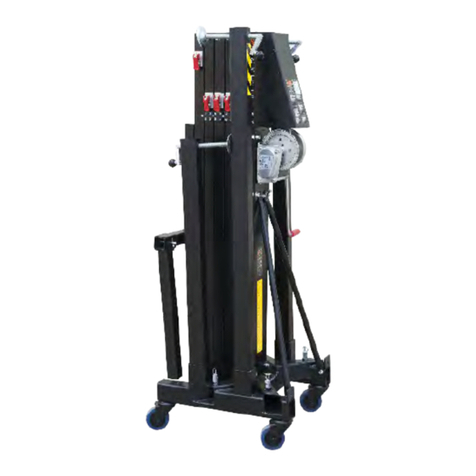
VMB
VMB Pro Lifts TL-063 Instruction Manual
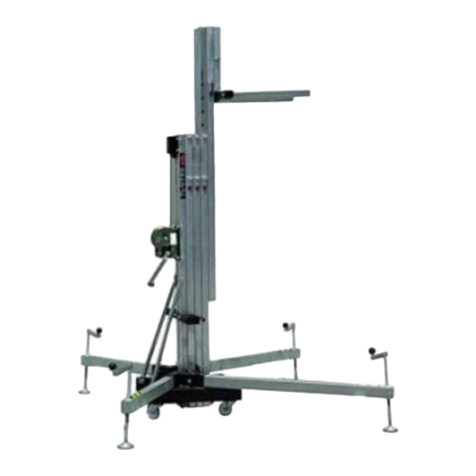
VMB
VMB TL-070 User manual
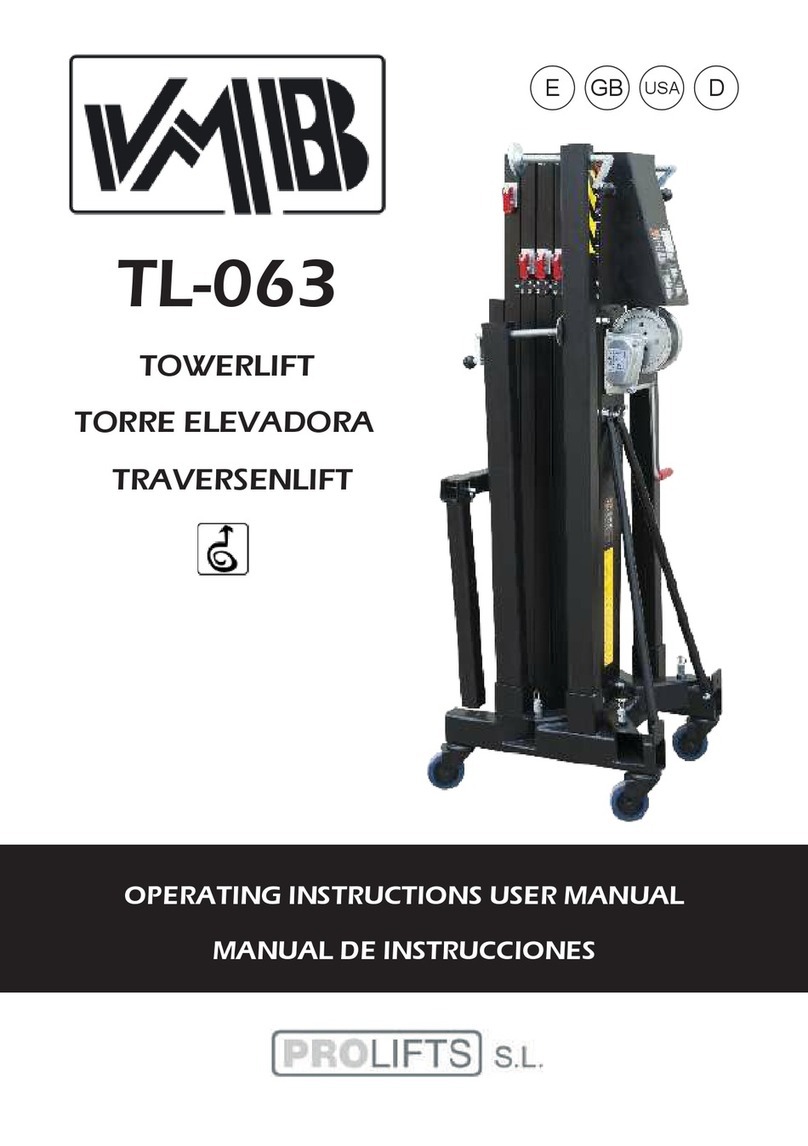
VMB
VMB TL-063B Instruction Manual
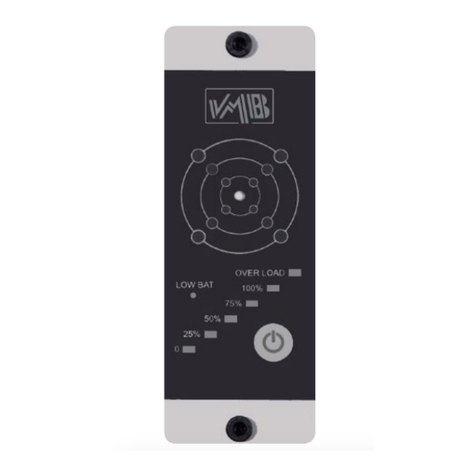
VMB
VMB SMART TOWERLIFT Instruction Manual
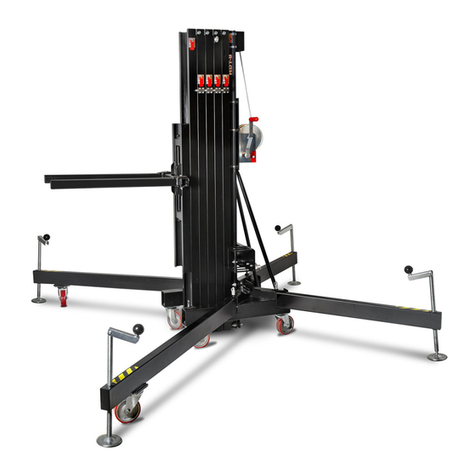
VMB
VMB HDT-8 Instruction Manual
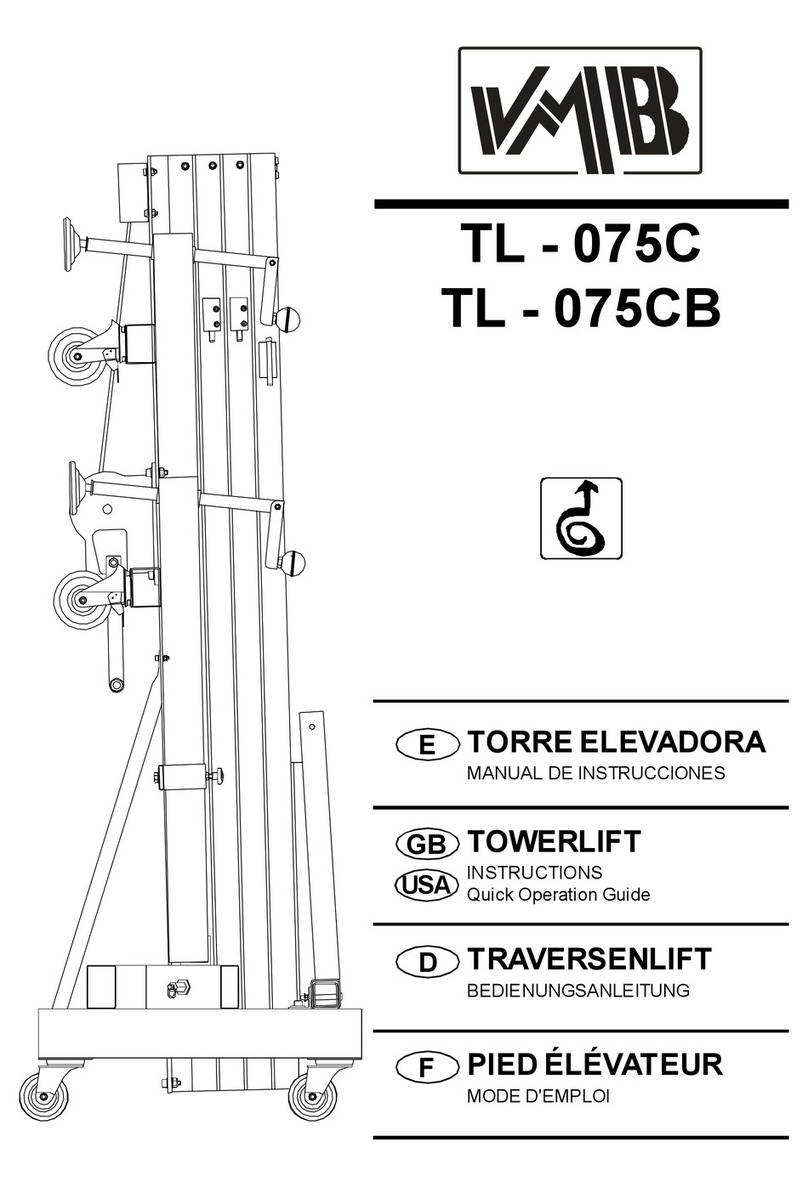
VMB
VMB TL - 075C User guide
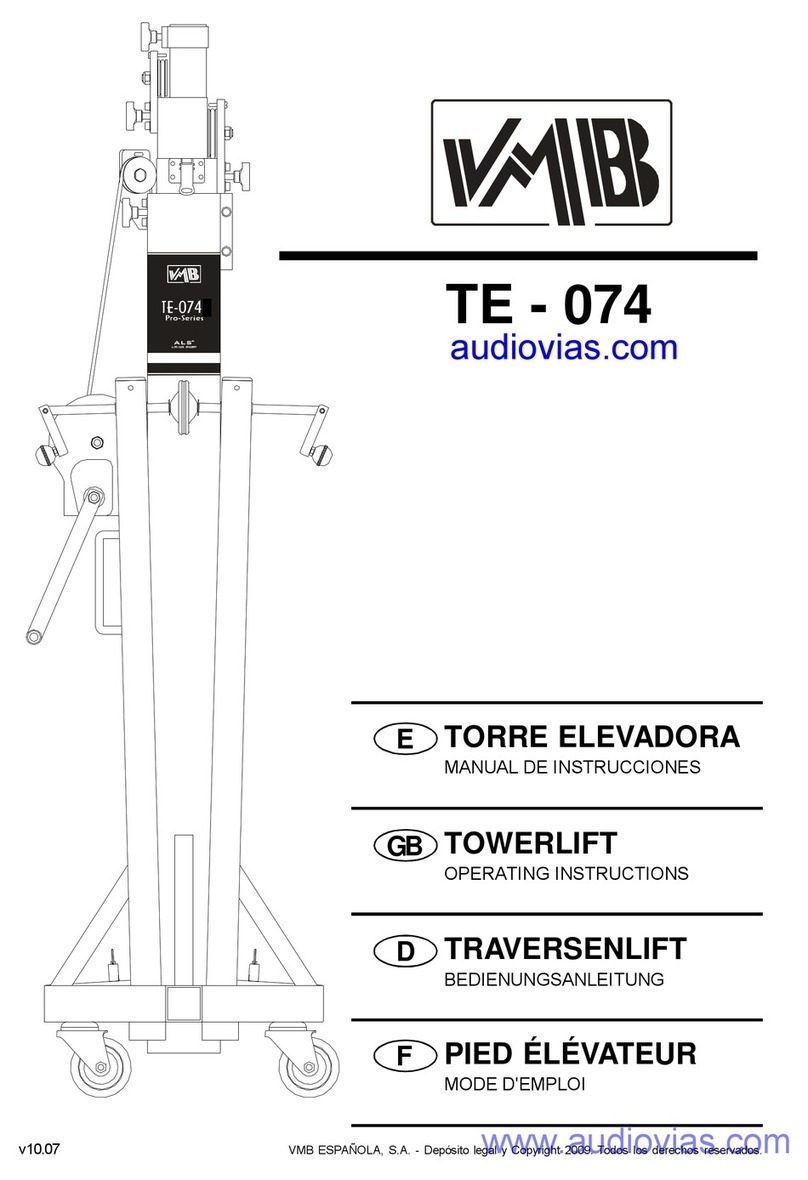
VMB
VMB TE-074 User manual
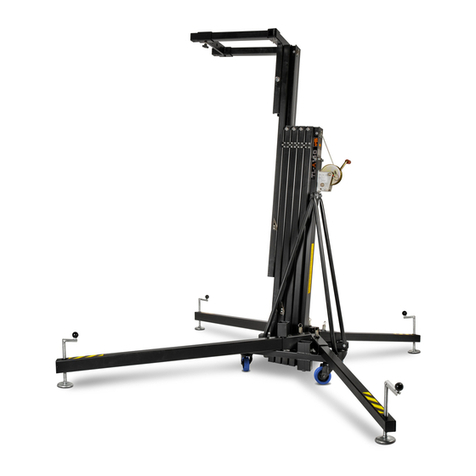
VMB
VMB TL-A150 Instruction Manual
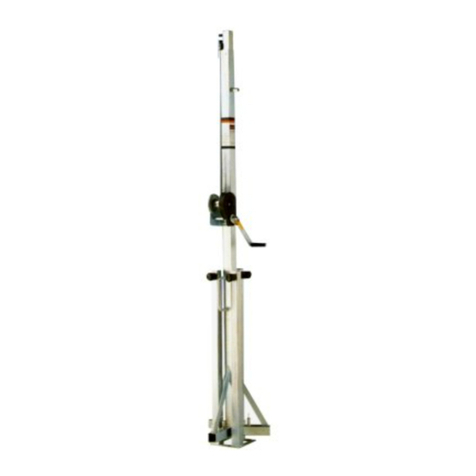
VMB
VMB TE-03 User manual
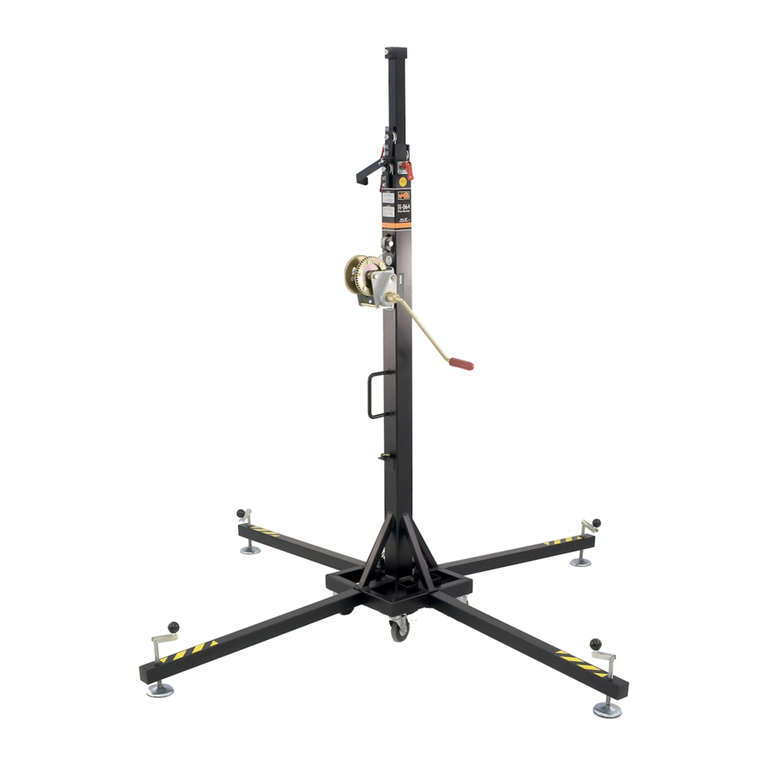
VMB
VMB TE-064 User manual
